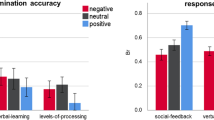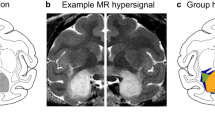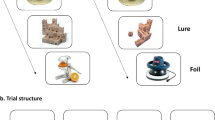Abstract
Contradicting the common assumption that accurate recognition reflects explicit-memory processing, we provide evidence for recognition lacking two hallmark explicit-memory features: awareness of memory retrieval and facilitation by attentive encoding. Kaleidoscope images were encoded in conjunction with an attentional diversion and were subsequently recognized more accurately than those encoded without diversion. Confidence in recognition was superior following attentive encoding, although recognition was markedly accurate when people claimed to be unaware of memory retrieval. This 'implicit recognition' was associated with frontal-occipital negative brain potentials at 200–400 ms post-stimulus-onset, which were spatially and temporally distinct from positive brain potentials corresponding to explicit recollection and familiarity. This dissociation between behavioral and electrophysiological characteristics of 'implicit recognition' versus explicit recognition indicates that a neurocognitive mechanism with properties similar to those that produce implicit memory can be operative in standard recognition tests. People can accurately discriminate repeat stimuli from new stimuli without necessarily knowing it.
This is a preview of subscription content, access via your institution
Access options
Subscribe to this journal
Receive 12 print issues and online access
$209.00 per year
only $17.42 per issue
Buy this article
- Purchase on Springer Link
- Instant access to full article PDF
Prices may be subject to local taxes which are calculated during checkout




Similar content being viewed by others
References
Claparéde, E. Recognition and 'me-ness'. in Organization and Pathology of Thought (ed. Rapaport, D.) 58–75 (Columbia University Press, New York, 1951).
Scoville, W.B. & Milner, B. Loss of recent memory after bilateral hippocampal lesions. J. Neurol. Neurosurg. Psychiatry 20, 11–21 (1957).
Schacter, D.L. Implicit memory: history and current status. J. Exp. Psychol. Learn. Mem. Cogn. 13, 501–518 (1987).
Gabrieli, J.D. Cognitive neuroscience of human memory. Annu. Rev. Psychol. 49, 87–115 (1998).
Squire, L.R. Memory systems of the brain: a brief history and current perspective. Neurobiol. Learn. Mem. 82, 171–177 (2004).
Hamann, S.B. & Squire, L.R. Intact perceptual memory in the absence of conscious memory. Behav. Neurosci. 111, 850–854 (1997).
Stark, C.E. & Squire, L.R. Recognition memory and familiarity judgments in severe amnesia: no evidence for a contribution of repetition priming. Behav. Neurosci. 114, 459–467 (2000).
Henson, R.N. Neuroimaging studies of priming. Prog. Neurobiol. 70, 53–81 (2003).
Schacter, D.L. & Buckner, R.L. Priming and the brain. Neuron 20, 185–195 (1998).
Schacter, D.L., Wig, G.S. & Stevens, W.D. Reductions in cortical activity during priming. Curr. Opin. Neurobiol. 17, 171–176 (2007).
Wiggs, C.L. & Martin, A. Properties and mechanisms of perceptual priming. Curr. Opin. Neurobiol. 8, 227–233 (1998).
Donaldson, D.I., Petersen, S.E. & Buckner, R.L. Dissociating memory retrieval processes using fMRI: evidence that priming does not support recognition memory. Neuron 31, 1047–1059 (2001).
Rugg, M.D. et al. Dissociation of the neural correlates of implicit and explicit memory. Nature 392, 595–598 (1998).
Schott, B., Richardson-Klavehn, A., Heinze, H.J. & Duzel, E. Perceptual priming versus explicit memory: dissociable neural correlates at encoding. J. Cogn. Neurosci. 14, 578–592 (2002).
Schott, B.H. et al. Redefining implicit and explicit memory: the functional neuroanatomy of priming, remembering, and control of retrieval. Proc. Natl. Acad. Sci. USA 102, 1257–1262 (2005).
Voss, J.L. & Paller, K.A. Fluent conceptual processing and explicit memory for faces are electrophysiologically distinct. J. Neurosci. 26, 926–933 (2006).
Paller, K.A. & Gross, M. Brain potentials associated with perceptual priming vs explicit remembering during the repetition of visual word-form. Neuropsychologia 36, 559–571 (1998).
Paller, K.A., Hutson, C.A., Miller, B.B. & Boehm, S.G. Neural manifestations of memory with and without awareness. Neuron 38, 507–516 (2003).
Voss, J.L., Reber, P.J., Mesulam, M.M., Parrish, T.B. & Paller, K.A. Familiarity and conceptual priming engage distinct cortical networks. Cereb. Cortex 18, 1712–1719 (2008).
Conroy, M.A., Hopkins, R.O. & Squire, L.R. On the contribution of perceptual fluency and priming to recognition memory. Cogn. Affect. Behav. Neurosci. 5, 14–20 (2005).
Jacoby, L.L. & Whitehouse, K. An illusion of memory: false recognition influenced by unconscious perception. J. Exp. Psychol. Gen. 118, 126–135 (1989).
Johnston, W.A., Hawley, K.J. & Elliott, J.M. Contribution of perceptual fluency to recognition judgments. J. Exp. Psychol. Learn. Mem. Cogn. 17, 210–223 (1991).
Keane, M.M., Orlando, F. & Verfaellie, M. Increasing the salience of fluency cues reduces the recognition memory impairment in amnesia. Neuropsychologia 44, 834–839 (2006).
Verfaellie, M. & Cermak, L.S. Perceptual fluency as a cue for recognition judgments in amnesia. Neuropsychology 13, 198–205 (1999).
Voss, J.L., Baym, C.L. & Paller, K.A. Accurate forced-choice recognition without awareness of memory retrieval. Learn. Mem. 15, 454–459 (2008).
Mulligan, N.W. The role of attention during encoding in implicit and explicit memory. J. Exp. Psychol. Learn. Mem. Cogn. 24, 27–47 (1998).
Gardiner, J.M. & Java, R.I. Forgetting in recognition memory with and without recollective experience. Mem. Cognit. 19, 617–623 (1991).
Mandler, G. Recognizing: the judgment of previous occurrence. Psychol. Rev. 87, 252–271 (1980).
Yonelinas, A.P. The nature of recollection and familiarity: a review of 30 years of research. J. Mem. Lang. 46, 441–517 (2002).
Yonelinas, A.P. Consciousness, control and confidence: the 3 Cs of recognition memory. J. Exp. Psychol. Gen. 130, 361–379 (2001).
Mecklinger, A. Interfacing mind and brain: a neurocognitive model of recognition memory. Psychophysiology 37, 565–582 (2000).
Paller, K.A., Voss, J.L. & Boehm, S.G. Validating neural correlates of familiarity. Trends Cogn. Sci. 11, 243–250 (2007).
Rugg, M.D. & Curran, T. Event-related potentials and recognition memory. Trends Cogn. Sci. 11, 251–257 (2007).
Voss, J.L. & Paller, K.A. Neural substrates of remembering: electroencephalographic studies. in Learning and Memory: a Comprehensive Reference (ed. Byrne, J.H.) 79–97 (Elsevier, Oxford, 2008).
Vincent, J.L. et al. Coherent spontaneous activity identifies a hippocampal-parietal memory network. J. Neurophysiol. 96, 3517–3531 (2006).
Curran, T. & Dien, J. Differentiating amodal familiarity from modality-specific memory processes: An ERP study. Psychophysiology 40, 979–988 (2003).
Evans, K.M. & Federmeier, K.D. The memory that's right and the memory that's left: event-related potentials reveal hemispheric asymmetries in the encoding and retention of verbal information. Neuropsychologia 45, 1777–1790 (2007).
Luck, S.J. & Hillyard, S.A. Electrophysiological correlates of feature analysis during visual search. Psychophysiology 31, 291–308 (1994).
Misra, M. & Holcomb, P.J. Event-related potential indices of masked repetition priming. Psychophysiology 40, 115–130 (2003).
Squire, L.R., Wixted, J.T. & Clark, R.E. Recognition memory and the medial temporal lobe: a new perspective. Nat. Rev. Neurosci. 8, 872–883 (2007).
Wixted, J.T. Dual-process theory and signal-detection theory of recognition memory. Psychol. Rev. 114, 152–176 (2007).
Wig, G.S., Grafton, S.T., Demos, K.E. & Kelley, W.M. Reductions in neural activity underlie behavioral components of repetition priming. Nat. Neurosci. 8, 1228–1233 (2005).
Levy, D.A., Stark, C.E. & Squire, L.R. Intact conceptual priming in the absence of declarative memory. Psychol. Sci. 15, 680–686 (2004).
Jacoby, L.L. & Dallas, M. On the relationship between autobiographical memory and perceptual learning. J. Exp. Psychol. Learn. Mem. Cogn. 110, 306–340 (1981).
Whittlesea, B.W. & Williams, L.D. The source of feelings of familiarity: the discrepancy-attribution hypothesis. J. Exp. Psychol. Learn. Mem. Cogn. 26, 547–565 (2000).
Clayton, N.S., Bussey, T.J. & Dickinson, A. Can animals recall the past and plan for the future? Nat. Rev. Neurosci. 4, 685–691 (2003).
Hampton, R.R. & Schwartz, B.L. Episodic memory in nonhumans: what, and where, is when? Curr. Opin. Neurobiol. 14, 192–197 (2004).
Westerberg, C.E. et al. When memory does not fail: familiarity-based recognition in mild cognitive impairment and Alzheimer's disease. Neuropsychology 20, 193–205 (2006).
Holdstock, J.S., Mayes, A.R., Gong, Q.Y., Roberts, N. & Kapur, N. Item recognition is less impaired than recall and associative recognition in a patient with selective hippocampal damage. Hippocampus 15, 203–215 (2005).
Acknowledgements
We thank S. Rearick for help with collecting pilot data and A. Gisbert and P. Reber for providing code used to generate stimuli. Financial support was provided by grants from the US National Institutes of Health (P30-AG13854) and National Science Foundation (0518800 and 0818912).
Author information
Authors and Affiliations
Contributions
Both authors designed the experiments, J.L.V. collected and analyzed the data, and both authors prepared the manuscript.
Corresponding author
Supplementary information
Supplementary Text and Figures
Supplementary Figures 1–3 (PDF 309 kb)
Rights and permissions
About this article
Cite this article
Voss, J., Paller, K. An electrophysiological signature of unconscious recognition memory. Nat Neurosci 12, 349–355 (2009). https://doi.org/10.1038/nn.2260
Received:
Accepted:
Published:
Issue Date:
DOI: https://doi.org/10.1038/nn.2260
This article is cited by
-
Neurophysiological markers of successful learning in healthy aging
GeroScience (2023)
-
The ecological validity of MET was favourable in sitting implicit sequence learning consciousness by eyes closed and eyes open resting states fMRI
Scientific Reports (2021)
-
Neurobiological basis of feeling of knowing in episodic memory
Cognitive Neurodynamics (2019)
-
Multi-level genomic analyses suggest new genetic variants involved in human memory
European Journal of Human Genetics (2018)
-
Newly-formed emotional memories guide selective attention processes: Evidence from event-related potentials
Scientific Reports (2016)



